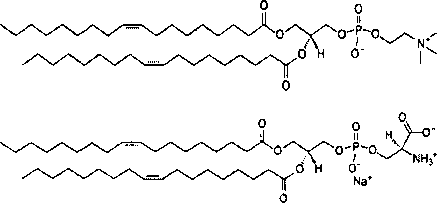would show short range deviations as before. In comparison, the force curve profiles over
gel phase lipid patch would not show such short range deviations.

Figure 3.11: (Top) DOPC-neutral at pH 7, (Bottom) DOPS-anionic. A mixture of these
lipids will be in fluid phase at room temperature.

O

Figure 3.12: (Top) DMPC-neutral at pH 7, (Bottom) DMPS-anionic. A mixture of these
lipids will be in fluid phase at room temperature.
Following section 3.2.2, we prepared a 4-lipid component mixture composed of DOPC,
DOPS, DMPC and DMPS. The DOPC:DOPS and DMPC:DMPS mixtures were of
identical molar ratios (both having 1:3, PS:PC) so that the lipid patches would have very
similar surface charge densities. The supported lipid bilayer made of the DMPC:DMPS
mixture has a gel-fluid transition temperature of 36 0C and forms gel phase patches at
room temperature [88]. The DOPC:DOPS mixture forms fluid phase lipid.
42
More intriguing information
1. On Dictatorship, Economic Development and Stability2. Non Linear Contracting and Endogenous Buyer Power between Manufacturers and Retailers: Empirical Evidence on Food Retailing in France
3. The name is absent
4. The name is absent
5. Needing to be ‘in the know’: strategies of subordination used by 10-11 year old school boys
6. Healthy state, worried workers: North Carolina in the world economy
7. The name is absent
8. Qualification-Mismatch and Long-Term Unemployment in a Growth-Matching Model
9. The name is absent
10. Aktive Klienten - Aktive Politik? (Wie) Läßt sich dauerhafte Unabhängigkeit von Sozialhilfe erreichen? Ein Literaturbericht